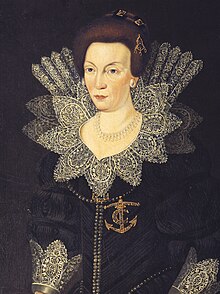Christine of Holstein-Gottorp
| Christina of Holstein-Gottorp | |
|---|---|
 |
|
| Queen consort of Sweden | |
| Tenure | 22 March 1604 – 30 October 1611 |
| Coronation | 15 March 1607 |
| Born |
13 April 1573 Kiel |
| Died | 8 December 1625 (aged 52) Gripsholm Castle |
| Spouse | Charles IX of Sweden |
| Issue | Princess Christina Gustavus Adolphus of Sweden Princess Maria Elizabeth Charles Philip, Duke of Södermanland |
| House | Holstein-Gottorp |
| Father | Adolf, Duke of Holstein-Gottorp |
| Mother | Christine of Hesse |
Christina of Holstein-Gottorp (13 April 1573 in Kiel – 8 December 1625 at Gripsholm Castle) was a Queen Consort of Sweden as consort of king Charles IX of Sweden, mother of king Gustavus Adolphus of Sweden, and a Regent of Sweden. She served as regent in 1605, during the absence of her spouse, and in 1611, during the minority of her son.
Christina was the daughter of Adolf, Duke of Holstein-Gottorp, and Christine of Hesse (daughter of Philip I, Landgrave of Hesse). In 1586, she was suggested as a bride for Sigismund of Poland, but nothing came of plans to marry him. On 8 July 1592, she became the second spouse of Charles, Duke of Södermanland, who in 1599 became Sweden's regent and in 1604 its king. She was crowned together with her spouse in Uppsala cathedral in 1607. According to legend, she encouraged her spouse to conquer the throne from Sigismund in 1598 because of her disappointment that she was never married to Sigismund.
Queen Christina was a domineering and strong-willed person with a strong sense of economy. She was both respected and feared. She has been described as hard, stubborn and stingy, and it is claimed that while the former wife of her spouse always tried to persuade him to show leniency in his acts, Christina did the opposite. She executed a very strict control over the court, which is illustrated by the anecdote that she measured up the sewing-thread for her servants in person. Her marriage has been described as happy, as they were very similar in personality. She accompanied him to Estonia and Finland in 1600–1601.
Christina is not considered to have dominated her likewise dominant and temperamental spouse, but she did not lack political significance and influence. Although her spouse did not let her dictate policy, he did ask her for advice in political matters. During the war with Denmark, he disregarded her advice and came to be in conflict with her because he suspected her to be pro-Danish. In 1604, Charles IX left instructions that she should be regent of the guardian government in the case he should die if their son and heir was still minor, and in 1605, she acted as regent during her spouse's absence in Livonia. She is also known to have prevented the election of her younger son Charles Philip to the throne of the Russian Czar in 1610–1612 by keeping him at home from the Russian election when he was to be sent to Moscow. She was reportedly relieved when the affair was terminated in 1614.
...
Wikipedia
